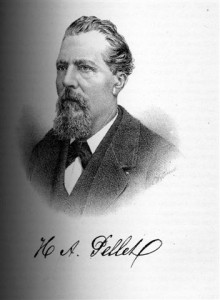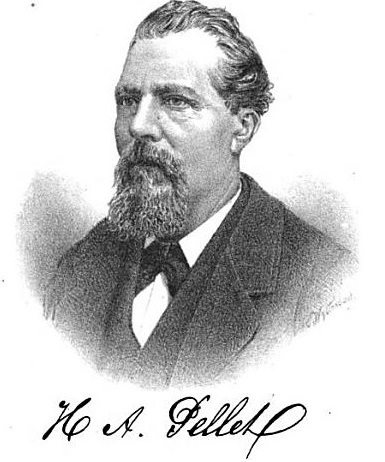The Summer 2012 Tidings covers the history of St. Helena, the heart of the Napa Valley. This excerpt originally appeared in Memorial and Biographical History of Northern California, published in 1891 by the Lewis Publishing Company in Chicago. To get your copy of Tidings, become a member today!
![]()
 It is with pleasure that we accord herewith a leading position to this worthy pioneer of wine-making in California, one who, by hearty, earnest work for the business of his life and the country of his choice, has accomplished much in the past with still greater promise of the future, and is to-day regarded as one of the foremost wine men of our State, being thoroughly acquainted with every detail of the business and an authority second to none other. A visit to his charming home, situated amid a splendid grove in the center of the valley, with an unequaled view on every side and surrounded by flowers, will long be remembered by the writer as one of those pleasant occasions that come all too infrequently to mankind. Very much of the general information to be found in another place in this volume has been verified and amplified from his ready stores of information. About his place nothing for show alone was found, but in every instance, in cellar arrangements and all else, utility and convenience was evidently first consulted. In the twenty-seven years since Mr. Pellet purchased and began the improvement of his charming place, he has done a very great deal of work, not alone for himself, but as well the State at large. From time to time he has imported and experimented with something like sixty varieties of grapes for the purpose of testing their adaptability to our climate and conditions. As a result, his experience limits him to about ten varieties, in which he is followed generally by others in the valley. These are, for red wines, the Zinfandel, Mataro, Grenache, Grosse Blanc, Carignane, St. Macaire and Malbec, and for white wines, the different varieties of Riesling, the Chasselas and the Burger. These are grafted upon native resistant stocks. The cellar, which has a capacity of about 80,000 gallons was erected in 1866, being sunk partially beneath the surface of the ground. That it contains samples of some of the grandest vintages ever grown in California, will be asserted by any one who visits Mr. Pellet and profits by his generous hospitality.
It is with pleasure that we accord herewith a leading position to this worthy pioneer of wine-making in California, one who, by hearty, earnest work for the business of his life and the country of his choice, has accomplished much in the past with still greater promise of the future, and is to-day regarded as one of the foremost wine men of our State, being thoroughly acquainted with every detail of the business and an authority second to none other. A visit to his charming home, situated amid a splendid grove in the center of the valley, with an unequaled view on every side and surrounded by flowers, will long be remembered by the writer as one of those pleasant occasions that come all too infrequently to mankind. Very much of the general information to be found in another place in this volume has been verified and amplified from his ready stores of information. About his place nothing for show alone was found, but in every instance, in cellar arrangements and all else, utility and convenience was evidently first consulted. In the twenty-seven years since Mr. Pellet purchased and began the improvement of his charming place, he has done a very great deal of work, not alone for himself, but as well the State at large. From time to time he has imported and experimented with something like sixty varieties of grapes for the purpose of testing their adaptability to our climate and conditions. As a result, his experience limits him to about ten varieties, in which he is followed generally by others in the valley. These are, for red wines, the Zinfandel, Mataro, Grenache, Grosse Blanc, Carignane, St. Macaire and Malbec, and for white wines, the different varieties of Riesling, the Chasselas and the Burger. These are grafted upon native resistant stocks. The cellar, which has a capacity of about 80,000 gallons was erected in 1866, being sunk partially beneath the surface of the ground. That it contains samples of some of the grandest vintages ever grown in California, will be asserted by any one who visits Mr. Pellet and profits by his generous hospitality.
We draw largely for the details of Mr. Pellet’s busy and useful life from the history of Napa and Lake counties, which gives them fully and succinctly. Henry Alphonse Pellet was born February 6, 1828, in the canton of Neuchâtel, Switzerland, and is the second son of John Samuel and Elizabeth (Javet) Pellet. He remained with his parents until he was fifteen years of age receiving in the meantime the rudiments of his education, and also working in his father’s vineyards. At that age he entered the high schools which he attended for two years. He then studied surveying for one year. In 1846 he accepted the position of book-keeper for Messrs. Perret & Co., watch manufacturers in La Chaux de Fords, which he held until February, 1848, when he resigned the position, and served as a volunteer in the revolution that freed the canton of Neuchâtel from the sovereignty of the King of Prussia. In May of 1848, he emigrated to the United States, and having brought a stock of watches, clocks, etc., with him set up in business in St. Louis. In the fall of that year he returned again to Switzerland, having disposed of his previous stock, and in the following spring came once more to St. Louis, bringing with him a replenished stock of watches and watchmaker’s goods. In the spring of 1850, determining to follow the tide to California, he fitted up two six-mule teams, and organized a company of twelve men for the trip overland. The trains were sent to St. Joseph, whither he followed by steamer; and on May 16th they set out for the tedious journey. They chose the northern route, coming via Sublette’s cut-off and Fort Hall to the Humboldt River, thence down that river to the sink, across the desert to Truckee and across the Sierras, reaching Nevada City, September 6, 1850. The trip was a hard one, much suffering being felt for lack of provisions and loss of cattle, necessitating the abandoning of one wagon. For six weeks they were without bread, and for four weeks had to subsist on jerked beef, procured from the abandoned cattle along the route. Mr. Pellet engaged at once in mining, and met with good success. In February, 1851, he with five others went to Rich Bar on the north fork of the Feather River, and worked for five months, returning then to Nevada City. In the fall of that year he with others opened a quartz mine, erected a mill, and in less than six months found the whole undertaking a failure. With the dauntless spirit of the early days, this disaster served only to nerve him to greater efforts. He accepted a position as foreman in a quartz mill at $8 a day, holding it until the fall of 1852. He then came to San Francisco, where in partnership with J. L. Cabanne he put up a flour-mill at North Beach. This they carried on for a year with varying success. In the fall of 1853 the mill was removed to Napa City, being the first steam grist mill in the county. This mill Mr. Pellet carried on until June, 1855, with no very large profit to himself, although an immense convenience and benefit to the farmers, who came many miles to have their grain reduced to flour. He then returned to the mines, going to Siskiyou County. In 1858 he came back again to Napa County, and engaged in farming. In 1860 he leased John Patchett’s vineyard near Napa City, and entered upon the making of wine. This was the second wine made in the county, Mr. Charles Krug having preceded him one year on the same place. In 1863 he purchased his present beautiful place, the whole of which (forty-five acres) is in vineyard, saving only the site of his comfortable home, the winery, barns, stables, etc. Until 1866 he had charge of Dr. Crane’s vineyard and cellar, when he built his cellar and, in partnership with Mr. D. B. Carver, now a banker, he went extensively into the wine business, buying grapes and making wine. The firm of Pellet & Carver was dissolved in 1878, since which time Mr. Pellet has continued the business alone, but on a like large scale. Mr. Pellet is now also the Superintendent of the wine cellars for the Natoma Wine Company, the most extensive makers of wines in the vicinity of Sacramento. He makes the wine for the company, attending to every detail from the moment the grapes come in from the vineyards until the wine is sold. He has always been actively identified with every movement that looks to the betterment of the wine industry of the State, being a leading figure in the formation of the Viticultural Commission. He has also held more than one elective office, in which he was able to serve his beloved industry to great purposes. In the session of 1885-’86, he was chosen a member of the State Legislature. During this time he was Chairman of the Committee on Viticulture, and was the author of the Sweet Wine Bill, and also aided largely in promoting Congressional action on the subject. Previous to this he had served his county and district as Supervisor for several terms, and was also for several terms a member of the Board of Trustees of St. Helena.
Mr. Pellet was married February 5, 1856 to Miss Sarah S. Thompson, of Sandusky, Ohio. They had three sons, Frank and Louis, now in the lumber business in St. Helena, two of the most worthy citizens of that town, who are following closely in the footsteps of their father, and John S. Mrs. Pellet is deceased, and Mr. Pellet has again married.
Such in brief is the record of a busy and eventful life, the characteristic feature of which is energy, indomitable pluck, and the strong determination that compels success – an example worthy the emulation of the young.
Pellet passed away June 3, 1912 of dropsy. His obituary in the St. Helena Star described him thusly:
“H. A. Pellet, has in years passed been prominently connected with the viticultural industry of Napa Valley, and was the owner of a large acreage on what is known as the Pellet tract, near town, which was later devastated by the ravages of phylloxera, in common with the other vineyards in the county. He had the distinction of being the second winemaker in the county, and the quality of the wine he produced is said to have been very superior…He was known far and wide for his kindly and generous disposition, and in the early days of the county was extremely liberal with his means in advancing its interests.”

